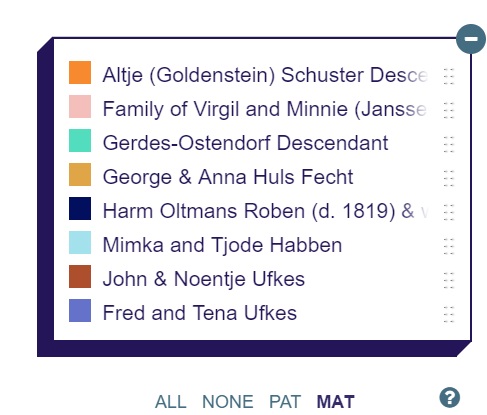
DNA analysis is more complicated when there are multiple relationships with your DNA matches and those relationships are close enough to impact the amount of shared DNA with those individuals. I’m not talking about multiple shared connections that aren’t known until the pedigree has been extended ten generations. These are double connections within five and six generations where there are no more recent shared ancestors, but because families married within the “community” double relationships are the norm.
That happens in my maternal families quite a bit. It’s common for me to have a relative on my maternal side who is a second and a third cousin, a third cousin two ways, or a second, third, and fourth cousin. Those relationships are close enough that there can be significant shared DNA. And because of the multiple connections, determining which portions of DNA should be assigned to a specific ancestor of mine can be somewhat difficult.
It’s suggested when using DNAPainter to assign groups to either an ancestral couple or a specific ancestor. That’s a good suggestion. But for my analysis and my own painting, I’ve had to tweak that just a little bit. Instead of using just ancestors as groups in DNA Painter, I’ve also assigned some individuals to other couples–ones who are related to me more than once. My method has been to assign individuals to either the most common ancestral couple or the “double connection” from whom they descend.
- Altje (Goldenstein) Schuster descendant–my great-great-grandfather Goldenstein’s sister whose child married a brother of my great-grandfather Ufkes
- Family of Virgil and Minnie-descendants of my Sartorius 3rd great-grandparents, my Fecht 4th great-grandparents, and my Bruns 4th great-grandparents
- Gerdes-Ostendorf descendant–a descendant of my Dirks 3rd great-grandparents and my Behrens 4th great-grandparents
- George and Anna Huls Fecht-my great-great-grandpa Habben’s brother and his wife–my great-great-grandpa Habben’s niece
- Harm Oltmans Roben (d. 1819)–a direct line ancestor
- Mimka and Tjode Habben–my great-grandparents
- John and Noentje Ufkes–my great-great-grandparents
- Fred and Tena Ufkes–my great-grandparents
It makes for more groups than I really would like to have. But if I don’t, the analysis is made even more difficult and I would be moving people between groups on a constant basis.
I do need to clean up my naming system and be more consistent in how I name these groups. The name of the group needs to be short enough to be displayed on all the various DNAPainter screens and detailed enough that it reminds me of who the matches actually are. That I’m still working on.
Learn more about getting started with DNAPainter in my downloadable webinar.

2 Responses
This is the first useful suggestion I’ve seen for dealing with this problem. In my paternal grandfather’s line, I have 3 lines of descent from the same couple (Gutridge Garland & Bridget Hampton of what is now Mitchell County, NC) and many of my DNA matches have more than that. For some of my matches I have 8+ different relationships, which makes assigning DNA segments nearly impossible. Then come the multiple marriages with specific other families, Yelton, Buchanan, and Stanley being my most common ones. I guess I should consider myself fortunate that so many descendants of these families have taken DNA tests, but mostly I just revolve in a ball of confusion.
Thanks. It can be confusing and I don’t see it being addressed too often–and I know that there have to be quite a few of us who have similar problems. Many of my mother’s 2nd and 3rd cousins share different sets of ancestors because of the multiple relationships-and the shared double connections are not all that far back–maybe sharing two or three sets of say great-great-grandparents. While a fair number have tested, it’s difficult to find someone who has tested that’s not a double cousin. The difficulty is compounded for the same reason as yours–when I get a little further back, I have quite a few “repeat” ancestors. The only good thing for me is that the paper relationships are fairly well documented, but as you say the DNA is initially a “ball of confusion.”
Three children of my Irish immigrants (married in the 1860s) married into the same family–two siblings and a first cousin who was actually a second cousin also. That makes separating out what’s the Irish DNA (so to speak) from what’s the DNA of the family they married into somewhat difficult as I descend from one of those three children.
We’ll keep posting suggestions of this type as time goes on.